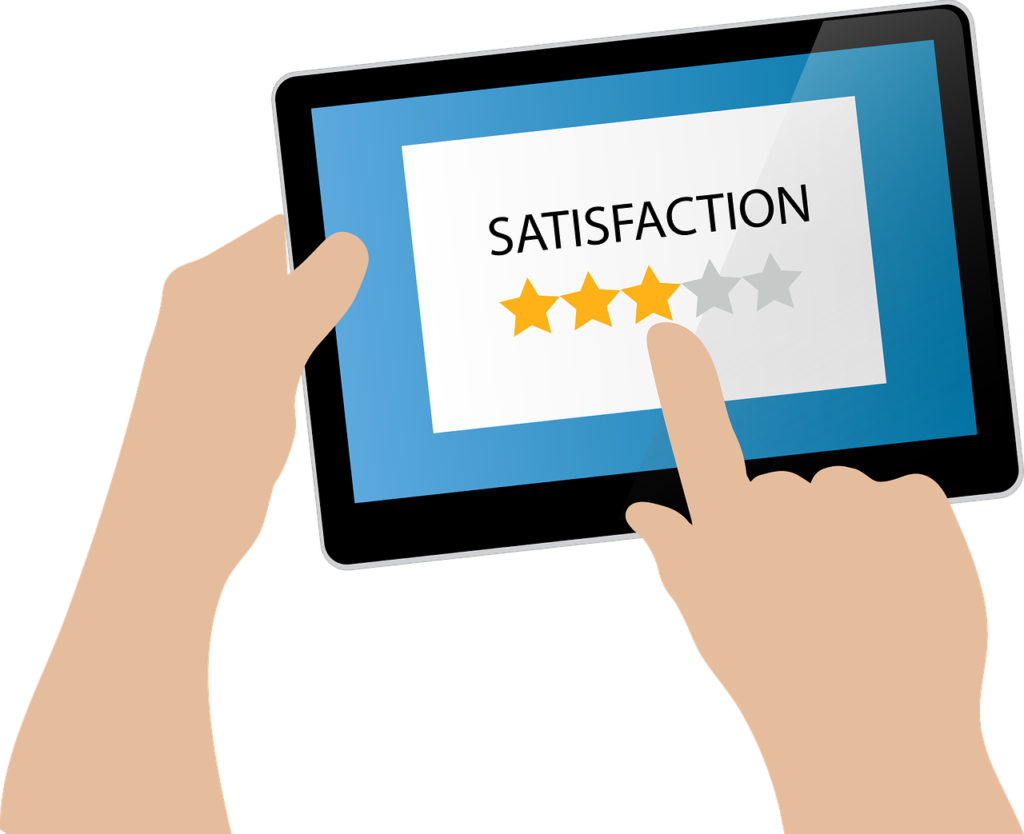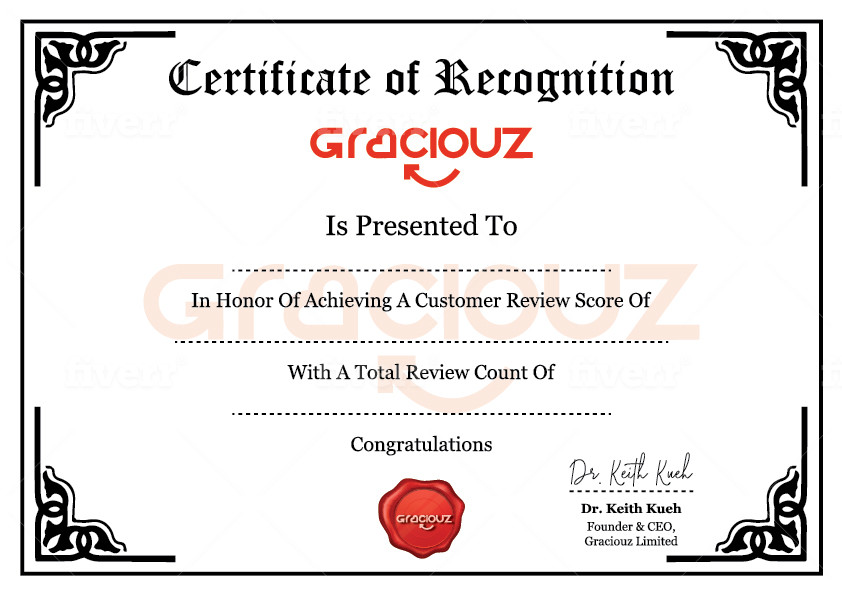Yes, you must get customers using reviews. Understanding customer experience matters more. Two months ago, I had a lengthy discussion with the CEO of a major retail electronics merchandise store. He told me that electronic merchandise that was explained, demonstrated, and answered by on-site staff have more than 80% chance of getting the sale versus displayed items. Such customer experience is by no doubt one of the best ways of customer engagement, and to address any concerns before making a purchase.
But, in the first place, how to draw the customers to the store? By sales promotions, customer reviews, referrals, availability of goods, or other means? Sales promotions are good techniques, but expect thinner margins, while the availability of goods might add up to inventory costs. This leaves reviews and referrals as the alternative cheaper option to get customers using reviews. But, think about customer reviews as credible referrals? Right! Most businesses would crave for good customer reviews to boost business reputation and credibility, but getting these reviews can be extremely challenging, if not nearly impossible.
From a customer standpoint, why should I leave a review? What do I get? I would only like to read others’ reviews, but to leave a review, maybe and only if my customer experience is extreme. And when I mention “extreme” here, it means too good or too bad, and in many cases, too bad drives more reviews than too good. So, incentivizing the customer to leave a good review should solve the problem, but pumping too many incentives will erode business margins again. So, what can be the best practice here?
On the other hand, let’s look at most of the other customer review platforms available. In most, if not all, customer reviews are mostly a 1-liner answer to sums up the full customer experience. Usually, the ratings are displayed by the number of stars (max of 5) or emojis and added by the quantity or number of reviews. Customers generally accept a higher number of reviews and the average review score as something meaningful and acceptable.

But, let’s dive deeper into a full consumer purchase experience such as a dinner at the restaurant. Ranging from the location of the restaurant to waiting time, to get seated, ordering and waiting for food, food taste, staff service during the meal, and finally to payment, etc. All these experiences to translate in a 1-liner customer review is by far too simple.
Quality of food or product is within the control of the provider or seller, but what about service to the customer? Service is an extremely subjective experience, where different customers may feel different when served by the same staff. So, how can we better quantify service as the customer? What’s the best practice here?
Customer Review Tips
Tip #1 – Is it better to segregate the types of customer reviews?
Human instincts and business senses have given us the cue to segregate customer reviews on business, product, and service altogether. From a customer acquisition perspective, sellers should provide a holistic view to address full customer experience. For example, what is your customer’s experience on the consumption of food, or the use of the product? What’s the pre- and sales experience? What about post-sales?
In other words, 1-liner customer review is way too brief, instead, and I strongly recommend focusing more on business, product, and service reviews separately.
Tip #2 – Should individual staff should have their personal customer reviews?
Yes, I mean customer reviews for each customer-facing staff. It’s never personal. Every staff has his/her good and bad days. Likewise, facing different customers of a different nature will entail different customer reviews too. For example, some customers might be looking for better product knowledge, and some might be looking for better product demonstrations or faster delivery, customer care, and so on.
I would say the implementation of a customer review based on individual staff is not an easy task. Fortunately, after exposing and interacting with enough staff myself, there is more acceptance than rejections.
To gain higher acceptance, you need to organize their awards and rewards around customer reviews monthly. It is, after all, a better service to close the sale and fairer to recognize staff who did exceptionally well in the eyes of the customer. Likewise, tailor appropriate training for your staff, according to customer feedback, and experience makes a lot of sense too.
Tip #3 – Why should you group staff according to their functions?
Be it a corporate- or retail-based operation, I strongly suggest to group staff on service reviews, which helps to provide a key service matrix to potential customers. For example, if a retailer has several staff at the TV or refrigerator section, grouping these staff for service reviews will help to provide a comprehensive customer review score for that group.
Having a baseline customer review score on an individual service group of staff will enforce a service standard within the group.
Tip #4 – Should you have different groups of staff in an Outlet or Department?
I strongly suggest segregating different groups of staff make absolute sense in the overall service to the customer. For example, in a grocery store, staff in the fresh produce, can food, fruits, cashiers, are groups of staff of its business function. Ultimately, a customer may shop around different sections of the grocery store to pick up different items.
Similarly, in a company, the delivery team versus the service engineers, presales specialists, etc., are different faces serving the customers, but as a representative of the seller. Customer experience and satisfaction will differ significantly through these functions

Tip #5 – Why should you use Claps as the rating scale?
I was told that customer review ratings through emojis could be intimating. After all, we are all human, not machines. But even machines can be prone to technical disruptions, what more to say about humans. But what about the stars? There are several customer review platforms using stars as ratings. Well, these stars can be socially acceptable, but not encouraging and motivational after all.
Then what about claps. We conducted a study with several businesses on the use of claps as a customer rating scale. The results were encouraging and meaningful. Firstly, customers are more encouraged to provide reviews given that its claps for the staff. Secondly, the staffs were more willing to ask customers for claps. Thirdly, it is not humiliating for staff, even if the service experience for customers were not perfect, but encouragements to staff to try harder for more claps.
So, given the benefits of using claps as customer review ratings, the quantity of reviews has increased versus the use of stars and emojis.
Tip #6 – How to better understand your customer?
This is a big topic by itself, but when I mention “understand your customer,” I mean what type of customer he/she is, e.g., critic, neutral, or compliment type of customer. Well, to any customer, providing a review is easy, based on his/her experience of the staff or the service or product.
But, getting more reviews from the same customer will further understand what type of customer he/she is—for example, a grumpy customer who always leaves 1 to 2 clap(s). Then we know, this is a critical type of customer, who would usually leave low-score reviews.
On the other hand, it can be a complimenting customer who mostly leaves 4 to 5 claps for their experience. So, any review left by these complimenting customers can all be good. But wait a minute, what if you get a critical customer, but leaves 4 to 5 claps for the staff?
Well, this means a lot to the staff and your business. Because knowing and understanding the customer in terms of review, nature will better understand the review score that you are getting now. Likewise, a complimenting customer who leaves a poor rating score can be devastating to the staff and your business. When such incidents happen, you desperately need to speak to the customer, or you will be losing this customer for good.
Tip #7 – Should you customize your business questions to understand your customers’ experience better?
All businesses need to understand their customer experience, and the way to ask specific questions are unique and different for each business. For example, the questions to understand the customer experience for a grocery store is entirely different as compared to electronic retail merchandise or a pet grooming specialist. So, having the ability to customize each question to understand the customer experience is a big plus as compared to just a 1-liner customer review platform.
Understanding customer experience can be a big boost in sales, marketing, training, customer service, and some other relevant departments. After all, all departments should be customer-centric, and operation emphasis should always focus on how to serve the customers better.
To make it simple, whichever company that best serves the customer using the easiest, simplest, and cheapest way wins the game. Isn’t it? So, let the customer tell you what to do!

Tip #8 – How to generate reports of your business questions to improve customer experience?
Well, you have tailored your business questions to understand the customer experience better. You need those customer answers to know what’s going on. Diving into those customer answers is a critical step for your business. Preparing management reports that can better align your business operations, according to customer requirements is key. So, we need to get a hand on those reports.
But what if there can be further integration work into your existing CRM or ERP or other kinds of in-house systems that these data can help you with your work. Perfect, isn’t it? To make things even more perfect, what about incorporating some artificial intelligence into the collected data to help you with making better business decisions? Wow, at this stage, it’s a big wow, if these intelligent functions can be available to make your work easier, isn’t it?
Tip #9 – How to get hold of that customers’ contact detail?
Many customer review sites either displays the customer reviews for soliciting more sales (such as an e-commerce platform) or a search engine that blindly displays customer reviews on behalf of your business. There is no avenue to either understand why the customers managed to express such reviews or a competitor trying to sabotage (in the case of a search engine), and not to mention if you would get the opportunity to speak with the customer in-length.
So, getting hold of the customer is key. This may not be in-person, but at least a contact info that allows you to further communicate with them. On the other hand, customers should be responsible enough to leave their names and contact information for further verification. I don’t mean the customer’s information should be made available publicly, but at least to the business (seller).
Further communications with the customer are crucial when further clarifications are required. For example, what can the seller do to change or better enhance the customer experience, etc.?
Tip #10 – How to get your customers to leave a token of appreciation?
Many customers might ask, why should I provide a review? Unless if the customer experience is extreme or if the customer is personally asked to do so. Many customers wouldn’t even bother to provide a review. This is a standard phenomenal across many industries and customer review platforms.
But, if you provide cash or a tangible incentive for a customer review, then maybe considered biased. In the eyes of the public, a biased customer review is not trustworthy. So, what should you do instead? Pumping cash marketing incentives is not a long-term solution too?
Well, the answer lies in the offering of a promotional coupon, e.g., a 50% discount for the next visit. The offering of promotional coupons drives returning customers (assuming if the customer experience is neutral to good). Customers are motivated to provide a review and return to enjoy the given perk. This is one good way to help your business and, at the same time, not spending valuable marketing dollars, and yet, drive returning customers — three birds one stone.
Tip #11 – How to leverage a sellers’ eco-system – Sharing customers?
Think about your customers sharing a review, and getting the reward from you. But what about other sellers’ customers providing a review, and getting that promotional coupon of yours? What about other customers who browse through the promotional coupons and decide to get that treat of yours. Your business will boom without much marketing effort, right? This is the power of sharing customers.
Dispensing promotional offers is a great idea for businesses. In many cases, even the distribution of promotional offers costs money, or at least costs marketing funds. So, the idea of sharing customers for all sellers makes absolute sense. I am not just talking about consumer-based retailers, but also B2B businesses as well. Imagine the amount of customer acquisition costs going lower from here. That’s a wow! Things are going to be exciting here.
Tip #12 – What about organizing private promotions for more return customers?
So, what about getting return customers with some ad-hoc time-based special offers? Without the need for any loyalty program or customer tracking platform, use the collected customer contacts through reviews to send private promotions. Well, what if the review platform provides mobile app or web notification alerts to those customers who had provided customer reviews before?
Wouldn’t such convenience be hard to come back? Just imagine you are just a click away to get in touch with your existing customers and get them to return on some special offers. How much would you spend for such convenience?

Tip #13 – What about a social media Wefie between the staff and the customer?
OK, before you get excited here, just imagine a fun and enjoying customer wefie with your staff. In this photo, your customers’ reviews (claps) and comments get displayed on social media. This is where things get exciting.
First, your customers get to enjoy a fun moment with your staff through a wefie. Second, your staff shares the fun and enjoys working on your business. Third, the customers’ and staff’s photos are displayed to other potential customers as a customer testimonial. And finally, more customers and staff would like to join in the fun. Voila, the fun moments of your business just get more exciting, right? Here, I am not just talking about B2C businesses, even B2Bs are possible.
Tip #14 – Why not compile customers’ Wefie on your website
Display the compilation of social media wefie on your website or repost them on your business social media accounts. Make the customer testimonials count. Spread the positive customer effect to more prospects. Increase the interactions with customers and prospects and get more likes. Let these customer interactions increase your business revenue
Tip #15 – Why it’s best to solicit customer reviews during purchasing
Well, this is pretty much a no-brainer feature. Getting customers to provide their reviews during their purchase far exceeds an experience recall. It’s much easier to seek a detailed customer experience than after purchase. Customer tender to be more cooperative and willing to share their experience when asked by the staff than to be prompted by other means for relating their experiences.
Tip #16 – Why it’s best to notify the manager-in-charge on bad customer experience immediately?
Getting customer reviews during purchase has other benefits – notifying the manager-in-charge in case of a bad experience. Yes, I mean to get the manager to speak with the customer before losing sight of them. This approach is one of the best advantages of getting customer reviews when the customer is around the business premises.
Imagine an unhappy customer left after a bad experience is one that you wouldn’t get to see them anymore. What if this unhappy customer decides to post his/her negative experience on social media? Well, business damage is worse.
Research and human nature have proven that most people tend to relate more about their bad experiences than good ones. Customers are humans too. The tendency to share negative experiences on social media or other platforms proves to be devastating to your business. It costs way more the effort and marketing resources to address the negative publicity than to build a strong and reliable brand.
Damage control can be very expensive. Well, pacifying customers face-to-face can be a lot easier and followed by an apology. 78% of the time, most customers will leave their unhappiness behind, and continue to purchase from you if their negative experience is resolved.

Tip #17 – Should you display customer reviews on your website
Many 3rd party customer review websites keep those reviews within their platform. Most of the online traffic is confined to their website, leaving businesses with little traffic to share. Needless to say, if the customer review website is an e-commerce site, then your business is further confined to the site and under their mercy on sales charges and credit card fees.
Displaying your customer reviews on your website has quite many benefits. First, you can build your store and keep the customer traffic to your site. Secondly, credible customer review scores compiled by a credible 3rd party customer review provider increase your business search ranking by up to 7%.
Thirdly, it’s easier for you to interact with your audience or prospects when you have the control. Weighing the pros and cons, it beats the odds to house your customer reviews than to work with those providers who keep customer reviews on their platform. Make sense?
Tip #18 – Segregate Business, Service, and Product Reviews
I have gone through the limitation and credibility of a 1-liner customer review earlier. It makes no sense to have just a 1-liner review. Customer reviews need to be further segregated into business, service, and products to provide a comprehensive overview of your business. Having more detailed reviews will provide better coverage and give more confidence to the prospective customers to deal with your business.
Most businesses are centric around products and services. If your products are generic or resale, competing on service to the customer helps to differentiate between your business and competition. But if your products are unique with key competitive matrixes, having product reviews will drive more sales.
Tip #19 – What about customer review rating certifications?
This is getting exciting again. Customer review certification is great for businesses, especially if an independent and credible 3rd party awards it. The business recognition would power your offline business as well? A nice certification display in the office would spice up customer confidence further.

Tip #20 – Should you work with an independent review platform?
I have spoken about this requirement for an independent review provider a few times in this article. So, let me sum this up at this point. Don’t get me wrong here, if there are customer review sites that house your customer reviews, that’s good. However, you are at their mercy of driving your online traffic to their site, or perhaps, you can get an iframe of those reviews on your product landing page.
This might not achieve the best customer review effect for building your business reputation and trust. However, you should work with an independent customer review provider that solely consolidates those customer reviews on your behalf.
Tip #21 – What about instant text chat with customers?
Wait, what’s this instant chat with the customer? Remember, in point #16, when I mentioned about notifications to the manager-in-charge during the bad customer experience? What if there are too many customers onsite, such as a weekend crowd at the grocery store or restaurant? How would you locate that unhappy customer?
So, an instant text chat connection between the manager and the customer will resolve this issue of locating the customer. Well, it’s done on the web page anyway, you don’t need to know the mobile or cell phone of both parties. Just an instant notification to establish the chat connection and both parties will start texting where to meet.
On the other hand, what about a convenient text chat with the customer? It would be nice to have an established text chat connection with customers. It would be much easier to inform them about upcoming events and promotions and get their RSVP and participation.
However, this is a double-edged sword. Some customers might start hassling your staff too. So, while it is good for business to be in direct touch with customers, the cost to provide that instant response to the customer will come at a price too. So, do consider this.
Tip #22 – What about getting good customers to chat with prospective customers?
This is an absolute treat if you have good customers to vouch for your business, and willing to recommend your business to other prospects. Imagine if a prospective customer checks up to the review and decide to ask a personal question to the other customer. A chat connection is established, and the good customer speaks on goodwill for your business. Wow, this is just too good to be true.
Again, this feature can be a double-edged sword. What if the prospect chooses to speak with a low review rating customer? Oh, this is going to be a nightmare for your business. Honestly, in all neutral stance, all prospect customers should be at their liberty to choose any customer to speak about their experience.
But for businesses, the bias to involve only good review customers is highly desired. So, I will leave this point as it is, but a platform to facilitate communication between customers and prospects is good, but the ability to control positive communication is highly desirable.
Tip #23 – What about an industry-based review rating for all businesses?
An independent customer review platform should consolidate review ratings based on industry, regardless of B2B or B2C. Adding confidence to customers and prospects, this will help to drive traffic and sales to those businesses who did well on customer reviews.
It also adds to an industry-standard for ratings and helps customers to choose the best for their purchase. Naturally, this will drive up the competition among businesses. But businesses are supposed to be competitive, right?
Tip #24 – Should you challenge your competitors on rating?
Well, it’s good to have a customer rating contest among businesses in the same industry or products. Ultimately, such contests should be time- and location-based to get the best results in a friendly competitive way. It will be exciting in the eyes of the customers to view and participate in such contests, and decide the winners.
Naturally, such contests will put a lot of pressure on the staff, but from the publicity and competitive point of view, it might be worth the effort. Of course, we ask business owners to duly reward their staff for their best effort serving the customers.
Tip #25 – What about customer tipping?
Another sensitive topic is that virtually non-existent in many countries. Many customers will take service for granted. Especially in the retail or F&B industries, some consumers do tip when service is served. Let’s look at customer tipping as a willingness from the part of the customer. It’s always a nice gesture and gratitude, but again, this is up to individual customers.
A customer review followed by a customer tipping will be extremely fulfilling to the service staff. Ultimately, most of the service staff are not well compensated, so a customer’s tip will truly make their day.
Tip #26 – What about staff recognition & promotion?
Many businesses have their systems for staff recognition. In most cases, the selections of staff on recognition awards are mostly internal, which are subject to bias and unfairness. However, the use of customer reviews on staff is a lot fairer in practice because customers are hardly in any position to be biased.
If the service provided to the customer is good, let the customer speak on behalf of the staff. All businesses serve their customers, and in these instances, may the best customer servicing staff win.

Tip #27 – What about searching for reviews?
When your business receives good reviews, you would love to have these reviews publicly available to draw potential customers. Businesses love to show they have served their customers well. All business owners share the same mindset. So, having a consolidated customer review platform to be public, unbiased, and truthfully reports these customer reviews will empower the customer service business.
Similarly, for customers searching for great business, product, and service, the customer review platform will help them to make the right buying decisions.
Conclusion
It’s been a lengthy document. If you are reading till this point, I thank you for your patience and willingness to find out more about customer reviews for the benefit of your business. Moving down the path of customer reviews is a challenge, but it is extremely rewarding to any business if it is executed right. Knowing your customers’ experience and feedback will bring lots of benefits to your business, and I wish you all the success in doing so.
At this point, I will like to congratulate you for looking at the right place. If you are looking for some of the key customer review points mentioned in this article, I strongly recommend that you sign up for Graz.me to get all these key points mentioned in this article. Graz.me provides the benefit to understand your staff in the eyes of the customers, and help you to better manage your employees using customer reviews and feedback to appraise performance, promotions, and provide the required skills training.
For staff, we highly encourage that you embark on a FREE personal service rating with your customers here
Let’s recap what we have discussed so far in the 27 different tips

One thought on “27 Tips To Get Customers Using Reviews Beyond 2020”